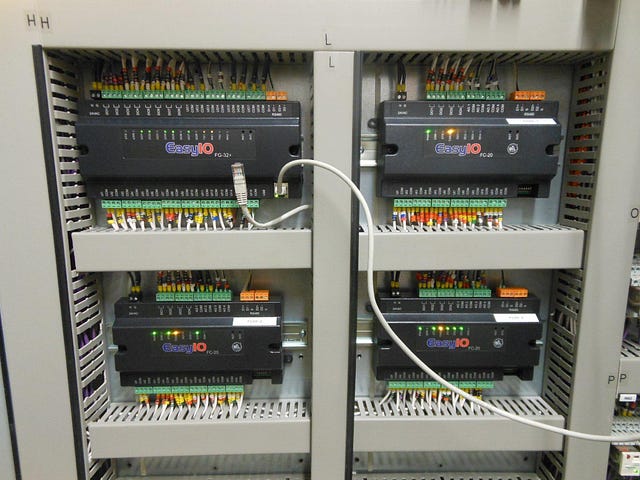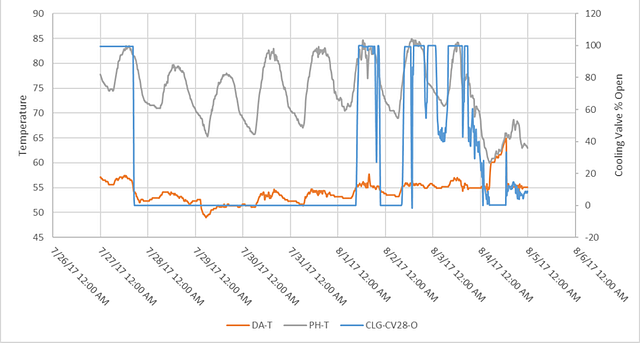The Potential of Machine Learning and AI for Smart Buildings
The Potential of Machine Learning and AI for Smart Buildings
- Last Updated: December 2, 2024
Matt Ernst
- Last Updated: December 2, 2024



Applying machine learning to smart buildings has the potential to completely change our relationship to the built environment. To understand how impactful this change could be, the current state of building controls needs to be understood.
The systems that make a building comfortable, safe, and enjoyable for their occupants are controlled (for the most part) by digital direct controls (DDC).
[caption id=" align="aligncenter" width="640"]

These devices have static programming, and are usually rarely adjusted or optimized after installation. These controllers are programmed to accomplish tasks such as the opening/closing a heating valve to maintain a 72 degree space temperature, or turning on/off the lights based on a schedule.
These devices use a limited number of sensors (inputs), to adjust the devices to a constant end result. Ideally, this allows the building to perform simple functions without the need for a human.
However, this paradigm leaves out this important piece: Humans. Buildings are controlled the same whether occupants are present or not. Building controllers do not care if you are comfortable. They do not care how much energy the building uses. They don’t have any inputs from people.
IoT and machine learning can add this critical piece. A data feedback loop from humans, and a way to crunch this data and do something useful with it.
IoT and machine learning can give buildings priorities (i.e. keeping everyone comfortable) instead of following rigid programming (i.e. keeping the space at 72 degrees).
The AI Version of Me
I don’t necessarily like to write about concepts that are not applicable today. Especially in the facility management industry, where innovative ideas tend to crawl for 10 years, then walk for 10, then finally get to running (mainstream adoption) after that. But I can’t help myself with AI for smart buildings because in a sentence:
I want a computer to replace me at my job.
That’s no exaggeration. Let’s start with what I do. I find ways to make buildings more comfortable, energy efficient, and run with less downtime.
That will all be done by AI in the future, and one day I hope to help advance the cause. Why? Because there is not enough time, money, or duplicates of myself to be constantly evaluating and identifying all the opportunities that exist 24/7/365 to make buildings run better. The most time I get in a typical building that I work in is a few months.
[bctt tweet="The facilities management industry is still figuring out what the role of higher computing power will be in the goal to better buildings." username="iotforall"]I use a combination of gathering time-series equipment operating data, on-site testing, and engineering judgement/calculations to understand how a building functions. I find everything that’s not working or could work better and come up with a detailed plan to make the fixes necessary to achieve the goals of the project. How could a computer do that? Well, the first stage is already being done.
Most of the analysis in my field of work is done in excel spreadsheets. Time-series data is exported from the building control systems, and poured over to look for insights.
[caption id=" align="aligncenter" width="640"]

The facilities operations industry has only recently begun to adopt analytic software to automatically sift through the massive amounts of data produced by buildings.
A lot of this manual analysis can be codified into “rules”, “functions”, or “algorithms” within these softwares to find the things that are important (too much energy use, broken equipment, etc). This is definitely the first step to better operating buildings, but it’s not a seismic shift. It is another tool in the toolbox of building operators to do their job more effectively.
If analytics is the logical next step from where we are today, machine learning and AI would be the gigantic leap right after.

The Value AI is Simple: Priorities
In theory, the following may be possible in the future. You could connect all the existing controllers in a building to a central computer with AI. You could allow the computer to watch the operation of a building and have it learn the existing rules, or have access to the existing logic. Then you could give it priorities and control over the existing controllers. For example,
Priority 1: Maximize occupant comfort
Priority 2: Minimize energy usage
Priority 3: Keep the building safe
Now, I realize this sounds crazy to most professionals in the industry. It’s way too broad. How would you accomplish these goals?
More data from more sources! Let’s use the HVAC example. Instead of the existing controllers being programmed to maintain 72 degrees for all areas of the building, you could do the following:
- Get real time feedback from occupants on their comfort level (through an app requiring occupant input, or possibly automatically through biometric data from a fitbit-like device)
- Understand where and when occupants are not comfortable and adjust the temperature in the space automatically
As you could imagine, this would require a significant expansion in the typical definition of “building automation and controls.” Never before has personal data been integrated into the function of buildings at this depth. It would require an incredible advance in complexity and IT sophistication.
Other more important Applications may justify the investment costs, especially where life safety comes into play like hospitals/clinics (i.e. if a patient who is highly contagious walks into a room, the system automatically increases the airflow exhausted from the room to reduce the spread of disease).
AI would be constantly doing my job. Taking in new data, crunching the numbers, weighing alternatives, and changing the way the building is controlled to meet the priorities.
The facilities management industry is still figuring out what the role of higher computing power will be in the goal to better buildings. The first step will be to use analytics and eventually AI as supplemental tools to inform the work of engineers and facilities management professionals alike.
Maybe one day a computer will replace me, but when it happens I won’t be disappointed. It will mean the buildings we work and live in will have become exponentially more enjoyable to spend time in, more energy efficient, and easier to maintain. And that’s a good thing.
The Most Comprehensive IoT Newsletter for Enterprises
Showcasing the highest-quality content, resources, news, and insights from the world of the Internet of Things. Subscribe to remain informed and up-to-date.
New Podcast Episode

What is Software-Defined Connectivity?
Related Articles





